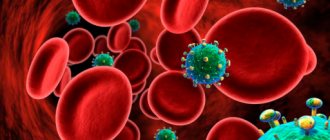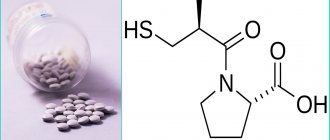Speaking about staphylococcus, it should be noted that this is not a disease, as many believe, but a pathogenic bacterium. Staphylococcal bacteria have many types and subspecies, and can cause a lot of diseases of bacterial origin. These can be diseases of the respiratory tract, skin, mucous membranes and even the digestive organs.
Staphylococcus bacteria have a spherical shape, and when multiplying, they can form colonies that resemble a bunch of grapes in appearance. When they enter or live in the human body, they are divided into opportunistic and pathogenic. Opportunistic bacteria simply live in the human body and, like any bacteria, can cause exacerbation of chronic diseases with which they are associated, however, this only happens under favorable conditions for the development of the disease.
Pathogenic bacteria are distinguished by their aggressiveness and when they enter the human body they immediately begin to attack it, causing various diseases. These diseases are treated mainly with antibiotics, and the use of antibacterial drugs is also possible.
A distinctive feature of staphylococcus bacteria is that they are capable of infecting all systems of the human body and that they are resistant to many types of antibiotics or, with prolonged use of the same antibiotic, are able to develop strong immunity to it (that is, treatment of a recurrent disease with the same antibiotic, as with primary infection, may not give results).
This feature greatly complicates the treatment of an infected person, especially when the disease recurs. Another feature of staphylococci is that with frequent manifestations of the same disease, it becomes chronic, and the bacteria settle in soft tissues and mucous membranes and live there quietly without creating any threat to human life and health. In this case, they are classified as opportunistic bacteria.
Staphylococcus can be detected both in the blood and in smears from the mucous membranes. The ways in which staphylococcal bacteria enter the body are quite different, but they enter the blood directly through the mucous membranes and soft tissues of organs, and, together with the blood plasma, are spread throughout the human body.
What is staphylococcus?
If you examine the pathogen under a microscope, you can see sedentary spherical cells. They accumulate, resembling a bunch of grapes.
Each strain of staphylococcus is characterized by a different degree of aggressiveness, so the health risks are also different. When the immune system is weakened and microbes enter the body, an inflammatory process develops.
Particularly dangerous are enzymes and toxins produced by microorganisms. Their effects affect the skin, subcutaneous tissue and connective tissue.
Staphylococcus can cause the development of the following diseases:
- sepsis,
- poisoning of the body,
- toxic shock,
- pneumonia,
- central nervous system disorders,
- purulent formations on the skin.
How can you be poisoned?
Food poisoning is caused not by the microorganisms themselves, but by the staphylococcal enterotoxins they secrete. Scientists divide them into 6 serological types and designate them with Latin letters: A, B, C, D, E, F.
Staphylococcal bacteria are dangerous because they can remain on frozen foods for several months, remaining viable. After the semi-finished food product is thawed, microorganisms continue to live and multiply. When exposed to favorable temperature conditions, they begin to actively develop and produce toxins.
The following products are most often contaminated:
- fish;
- canned vegetables;
- marinades;
- dairy products;
- semi-finished meat products;
- cakes, pastries.
One of the most favorable environments for staphylococcal microorganisms is considered to be products made from milk. This is evidenced by the fact that most often food intoxication occurs due to the consumption of milk, kefir, cottage cheese or cheese. At home, pathogenic processes in milk and its processed products begin to occur already at a temperature of 18-20 degrees.
If food products are stored at room temperature, enterotoxins are formed after 8 hours, and in the case when storage occurs at 36-37 degrees, pathogenic processes begin to occur within 5 hours after the start of storage. Staphylococcal food poisoning is possible when eating curd products made from milk that has not been sterilized. Also of great danger are feta cheese, sour cream, and cheeses produced using rennet.
Products that may contain staphylococcus
Heat treatment is not a measure that can reliably prevent infection with staphylococci and the formation of enterotoxins . It is necessary to boil and pasteurize products, but only to reduce the likelihood of the development of pathogenic processes.
Detection of staphylococcus in children and adults
Pathogens can be found in both infants and older children. In the first case, the baby can become infected if the mother’s staphylococcus is in a calm state during pregnancy and lactation. It's in breast milk. Also infection during and during childbirth.
Staphylococcus is practically not dangerous for adults provided they have a strong immune system. It may progress if:
- suffered an acute respiratory infection,
- was treated with antibiotics,
- a person is recovering from surgery,
- injured
- Dysbacteriosis was detected.
An adult has many more ways of penetration of Staphylococcus aureus. Provoking factors include:
- sexual contact or simple communication with an infectious person,
- use of non-sterile equipment in medical institutions. Sometimes infection occurs during artificial ventilation,
- blood transfusions and intravenous injections.
To protect yourself from infection, you need to know how this pathogenic bacterium is transmitted. There are several routes of infection:
- through the respiratory organs,
- through the mucous membrane,
- by blood
- with food products,
- through skin contact with infected objects.
Risk factors for developing staphylococcal infection
- The use of catheters in hospital conditions, the use of ventilation, during surgical manipulations through surgical instruments.
- Immune suppression before transplantation or implantation.
- Carrying out hemodialysis.
- Intravenous nutrition of premature infants.
- Diseases accompanied by decreased immunity (AIDS, diabetes, cancer, some lung diseases, skin and heart diseases).
- Intravenous drug administration.
- Piercing, tattooing.
Main routes of infection
Doctors are confident that this bacterium can be transmitted from person to person. People with weak immune systems, as well as those who neglect the rules of personal hygiene, are at increased risk. Routes of infection are blood, skin, mucous membranes, open wounds and burns.
A healthy person can become infected with a staphylococcal infection under the following conditions:
- Medical equipment and instruments are not properly processed. Ventilation, intravenous nutrition, and hemodialysis also pose a risk. If a person undergoes such procedures, then by default this indicates poor immunity. For this reason, bacteria multiply quickly and attack organs.
- Staphylococcus can be the main source of food contamination. In particular, this applies to dairy products, meat and eggs. When it enters the body, the bacterium attacks the intestines and causes severe poisoning of the body.
- Pathogenic microorganisms can be transmitted by coughing or sneezing, that is, by airborne droplets. Simply being near a sick person is enough to become infected.
- The household route of infection is also considered common. Staphylococcus aureus can easily withstand different temperatures, so it can live on different objects of use. For this reason, it is important to always wash your hands after touching other people's things.
- Infection with staphylococcus in a hospital occurs through contact with other patients who have an erased form of the disease or with carriers of the bacterium.
- An equally common route of infection is sexual contact with a carrier of staphylococcus. It is especially dangerous in such cases to neglect contraceptive methods. It is known that the infection is freely transmitted through the mucous membrane of the genitourinary system.
Staphylococcal infection almost always develops against the background of reduced immunity. Pathogenic microorganisms multiply more actively if there are other viruses in the body, as well as pathogens of dysbacteriosis.
Infection during childbirth
During delivery, various microtraumas or wounds may occur, which is a high risk of infection for the child. As a result, the newborn may develop skin rashes with the presence of purulent masses. There is also a high risk of damage to the respiratory and blood organs.
Infection during lactation
If there is an infection of this kind in a woman’s body, then it passes to the baby through breast milk. When staphylococcus enters the child's intestines, dysbiosis occurs with various symptoms and complications.
If the child is infected in another way, then when sucking the breast, he can transmit staphylococcus to the mother. The baby's saliva enters the body through cracks in the nipples. As a result, inflammation develops, developing into purulent mastitis.
Risk of infection through kissing
Staphylococcus is certainly transmitted through mucous tissues. Saliva with bacteria is dangerous for a healthy person, so kissing is one of the main ways of transmitting infection.
Staphylococcus infection from pets
Many pets are carriers of Staphylococcus aureus. Their bite is very dangerous to human health, since infected saliva penetrates the skin into the body.
Risk of sexually transmitted infection
During unprotected sexual intercourse with a patient, infection can occur through the mucous membranes of the urinary system. Even if a person is simply a carrier of staphylococcus, sexually transmitted infection is difficult to avoid.
The most dangerous products
An increased danger for adults and children are cream products that contain a lot of sugar, starch and water: all kinds of cakes, pastries and pastries with cream filling. A special category of hazardous food products is meat, poultry and semi-finished products made from them.
In this environment, pathogenic staphylococci thrive and produce enterotoxin at an increased rate. Meat often becomes infected with staphylococcal microbes while the animal is still alive. Typically, this occurs as a result of an inflammatory disease.
Important! It is strictly not recommended to buy meat and fish products in dubious places and from sellers who do not have sanitary records and documents confirming the safety of the goods.
Contamination of meat with pathogenic bacteria capable of producing enterotoxin can occur even after the animal has been sent for slaughter. The production of canned food, sausages and semi-finished products is a multi-stage process, and danger lurks at every stage. It is almost impossible to distinguish the taste of contaminated food products from high-quality ones, which is why staphylococcal poisoning so often occurs when consuming canned food, especially vegetables, fish and seafood.
Externally, the cans look absolutely normal, do not swell, and upon opening there is no unpleasant odor, uncharacteristic appearance or other signs that could indicate damage to the product. Food products that have been boiled, pasteurized or sterilized cause poisoning no less often than unprocessed ones . With strong heating, antagonist microbes die, resulting in the most favorable environment for the life and reproduction of staphylococcal bacteria.
What is the danger of infection with staphylococcus?
Infection with staphylococcus can cause the following consequences:
- Diseases of the urinary system, which include pyelonephritis and cystitis.
- An inflammatory process occurring in the lungs.
- Skin diseases: eczema, dermatitis and furunculosis.
- Purulent diseases of internal organs, most often we have to deal with peritonitis and abscess.
- Inflammation of the brain, otherwise called meningitis,
- Gallbladder disease.
Contact infection
Infection with staphylococcus occurs because the pathogen overcomes the defenses of the macroorganism. Transmission of staphylococcal infection by contact involves infection through touch. The bacterium reacts little to the factors by which the surrounding world influences it: it is resistant to temperature changes and some types of antiseptics.
Staphylococcus aureus often lives on human skin, but the danger of getting sick appears only with extensive wounds or against a background of weakened immunity. However, such a person can become infected with staphylococcus, since he is a carrier of the pathogen. Through direct contact with it, as well as through household objects, these pathogenic bacteria can spread.
What methods exist to prevent staphylococcus infection?
Everyone, regardless of age, should know about the prevention of staphylococcus and staphylococcal infection. This microorganism has become more resistant to various antibiotics and antibacterial agents, that is, the risk of harm to health becomes higher.
You need to know that in dried form the bacterium lasts for about 6 months, and in dust – up to 3 months. Staphylococcus is not afraid of frost and sunlight. It can be killed by boiling. When treated with a 5 percent phenol solution, neutralization can be achieved for 15-25 minutes. The bacterium is especially sensitive to brilliant green.
To avoid health problems, you need to follow simple rules:
- Mandatory personal hygiene. Hands should be washed more often and more intensively.
- Improving the body's defenses. It is recommended to lead an active lifestyle, toughen up, play sports, eat right, and not abuse bad habits. All this has a positive effect on the body's immunity.
- Preventive vaccinations and other measures against seasonal epidemics.
- Timely treatment of diseases occurring in acute and chronic forms. Particular attention should be paid to problems such as dental caries, inflammatory processes in the nasopharynx, boils, adenoids, inflammation of the genitourinary system, and stye on the eye.
- Accepting only high-quality food products with good packaging, heat treatment and expiration dates.
- Following the rules of cleanliness at home or in the workplace, especially with regard to regular ventilation.
- You should not visit medical institutions with a dubious reputation, as well as nail salons, solariums and other similar places.
- It is necessary to ensure that medical instruments are handled correctly and that no sanitary errors are made.
If there is the slightest suspicion of staphylococcus infection, it is better to consult a doctor immediately. Timely, proper treatment will prevent the development of serious health problems.
Therapeutic measures
If staphylococcal food intoxication is suspected, the patient must contact an infectious disease specialist and receive a referral for hospitalization. Treatment with antibiotics, herbs, ointments and other remedies at home is unacceptable. Therapy is carried out in the infectious diseases department, while the patient is isolated from other patients to avoid infection. Treatment for a disease resulting from staphylococcal food poisoning is similar to a set of anti-epidemiological measures for salmonellosis.
First, the patient is given an enema with a large amount of water and vomited to rid the digestive tract of toxic contents. Then they give astringent antidiarrheals to drink to consolidate the stool. It is mandatory to take activated charcoal and a saline laxative. These products cleanse the stomach of remaining toxins.
The complex of treatment measures includes:
- a warm heating pad on the abdominal area,
- subcutaneous injection of saline or glucose,
- camphor injections.
A 5% sodium bicarbonate solution helps effectively remove toxins. In cases of severe dehydration, which occurs as a result of clostridia intoxication, rehydration measures are prescribed. Severe dehydration is eliminated by administering an isotonic sodium solution, alone or with the addition of an equal volume of 5% glucose solution.
Good results are shown by the use of the drug "Trisol" in combination with a colloidal solution. This combination ensures rapid removal of toxins, has a rehydration effect and helps restore blood microcirculation. To increase the effectiveness of treatment, the patient may be recommended to take immunomodulatory drugs, as well as agents that restore intestinal microflora.
Antibiotics for the treatment of staphylococcal poisoning are not prescribed due to their low effectiveness. A gentle diet based on light, low-fat dishes is more effective. During and after treatment, the diet should consist of vegetable soups, lean broths, cereals, and freshly prepared stewed vegetables. Until complete recovery, it is not recommended to consume meat, fish, dairy, fermented milk and cheese products (to avoid relapse).
Therapeutic measures
The task is not easy. The most important thing is to find out whether the pathogen is resistant to a certain type of antibiotic. The use of bacteriophages and broad-spectrum antibiotics are the most popular methods.
Before prescribing treatment, it is mandatory to perform a culture from the painful lesion to determine susceptibility to drugs. Then the specialist prescribes a combined examination, which includes taking immunomodulatory drugs that restore normal microflora.
The most important thing is to complete the course of therapy and follow all doctor’s recommendations.
Clinical manifestations
Staphylococcal infection is very insidious. It can affect almost all organs, tissues and systems.
The clinical picture will depend on where exactly the infection has taken root. Therefore, no symptom should be ignored.
Then it will be possible to identify the cause in time and make a correct diagnosis. Staph foodborne infections are the most common of all those caused by these bacteria.
In this case, the gastrointestinal tract is affected. The patient cannot eat normally and quickly loses strength.
Cleanliness is the key to health
Staphylococcal foodborne illness is primarily the result of unsanitary conditions. If only healthy workers who carefully follow all processing rules and regulations are allowed to handle food products, then the likelihood that a large number of bacteria that can lead to illness will enter the consumer’s body is minimal.
Particularly unsanitary conditions are terrible in various hospitals, maternity hospitals and burn departments. If a large number of bacteria enter a weakened body, this causes serious complications.
Aerogenic infection
When considering how staphylococcus can be transmitted, it is imperative to note airborne infection. A dangerous bacterium can often live on the nasal mucosa for a long time. In most cases, the carrier of staphylococcus is completely healthy. The growth and reproduction of pathogenic microorganisms occurs with a decrease in immune forces. As a result, adults develop diseases such as rhinitis, sinusitis and others. Pneumonia caused by staphylococcal infection is considered a particularly dangerous case.
Nutritional route
The source of Staphylococcus aureus can be food. Because the infection is resistant to heat and freezing, people often become infected through food of animal origin. When entering the stomach, the bacterium releases toxic substances that cause severe poisoning, but if there is no damage to the mucous membrane, it quickly dies under the influence of hydrochloric acid.
When a person has wounds on the gastric mucosa, the worst thing happens is that Staphylococcus aureus is dangerous: poisoning and the spread of infection, quickly leading to the death of a person, even if medical assistance is provided on time.











